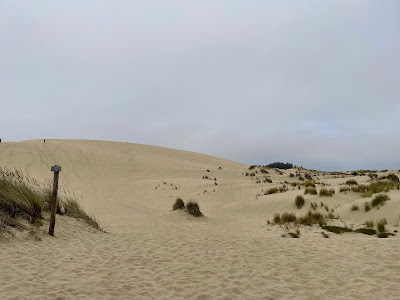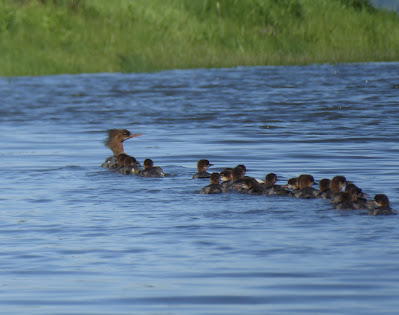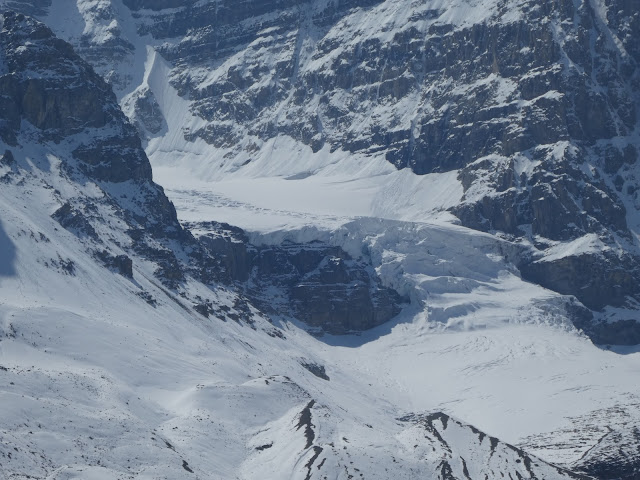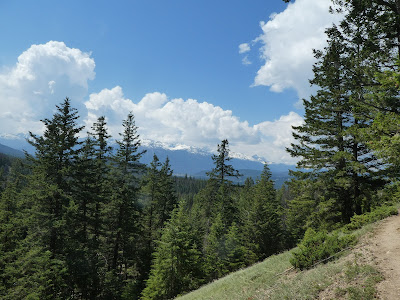Glaciers –

Everything around here is about the ancient and current glaciers; where they were, what they did, how they impacted the land. We are talking about rivers of ice that are thousands of feet thick and hundreds of miles long. They compress the ground underneath them into huge flat sand covered plains. They plow the mountain valleys picking up errant rocks and boulders, breaking them down and pushing them to the sands creating long tall moraine that run the length of the ancient glacier valleys. They slowly move and grind against the remaining side and bottom stone, sanding the stone smooth but also creating a fine glacial silt that turns the rivers and lakes a beautiful blue green or a muddy grey. When they retreat they leave large stands, terminal moraine, of carried rock where their toes rested a century or so. All of the glaciers in the Canadian Rockies are in rapid retreat in these days of global warming. The lodge and park center at the ancient terminal moraine of the Athabasca Glacier was built were the toe of the glacier was in the late 1800s. The new highway if 100 feet closer to the glacier. The road leading to the parking lot near the glacier goes on for a quarter of a mile. Then there is another quarter of a mile hike up over a rock ledge to get as close as you can walk to the glacier without a guide. The parking lot was covered by glaciers in the 1930’s. The ridge you scale was covered in the 1950’s. As close as you are allowed to get was covered in the 1990s. They need to redo the park and move the signs and the barriers because they are not up to date and don’t let you get as close as the park would allow. Hell, they were set up over 20 years ago when the Glacier was right there on this side of the rise !!
 |
Intersecting Glaciers created the overlapping Moraines seen here
Behind them is a nice triangle of forest. |
I wish I had a pocket geologist along with me to explain the many glacial and rock features that we encountered over the last few days. Might need a limnologists and a glaciologist. See, this is what AI would be really good for, answering my little questions on the fly. I point my pocket AI (today, called, for some reason, a phone) at the feature, say a giant straight pile of rock, and the AI would say, “Why Jon, clearly that is a lateral moraine that was built up by the Athabasca Glacier when it extended down through this valley 20,000 years ago. Dr. Steward from the University of Vancouver BC has some fascinating papers on this particular flow that I will queue for your nightly light reading”. Goddamn smartass pocket AI’s.
 |
Deep Canyon Dug
Under glacier by Melt |
Another cool glacier creating is some of the deep canyons that are in the area. We visited two of them: one at Athabasca falls, and one at Maligne Canyon. Both were created in similar ways, not so much by the growing glacier but by the river of melt water that would flow under the retreating glacier. This cascade of water would be, well, river sized, during the summer and could be pushed into a narrow area by different flows of lava rock, especially rock of different hardnesses. This quick flowing stream would be forced to dig down instead of sideways making very deep and narrow defiles that carried (and still carry) the water. I must write more about each feature separately.
Lastly is the lakes. As the glaciers advance and retreat they leave nicely rounded holes in the stone that make lovely little (or large) shallow water lakes, blue-green with glacial silt and sparkling in the summer sun. In some places, the glacier was kind enough to leave a terminal moraine at the foot of the depression creating a lovely little natural dam to make the lake even larger and deeper. Check out this satellite image of the lake at Wallawa in Oregon.
 |
The Glacier is South up the Mountains.
The Dam Moraine is at the Top |
Driving South down the Icefields Parkway.
Heading south from our campground we are driving on highway 93A, which runs parallel to the main drag, 93, which is east on the other side of the Athabasca river. We can’t see it. We are on the very edge of the large flat plane that was made by the gigantic ice age glacier of Athabasca as it smashed the local terrain flat up to the encroaching mountain sides. We drive down past a number of little round mountain lakes, some that are advertising boat (canoe) launches. These are the same shallow water glacial lakes that like those we hiked on the trail of 5 lakes. In the early morning, there is no wind and they make wonderful mirrors for the backdrop of snow covered Canadian rockies.
After a bit we come to the Athabasca river, turn a corner and immediately go over a bridge that is much to small to actually cross that big river. What happened? We just went over the gorge that contains Athabasca falls. This is a gorge created in a similar fashion as the Maligne gorge when the melting glacier forced the river that was forming under it to find its way through the harder rock of this small area. The result is a set of wonderful water channels (current used and long ago abandoned) with Athabasca falls at the head of the canyon.





This is a great place to get out and explore. There were a number of tour busses there when we arrived, but don’t let that slow you down. The visitation paths of this area and the viewing angles provided for the falls and the canyon are amongst the best designed I have ever seen. We had a great time viewing the falls and walking around. There is an ancient, long abandoned, water channel that is now a walkway and as you walk it you can imagine how the etching of the stone would have occurred on how this channel would have eventually lost its flow as the current channel grew deeper and so dragged the water away. Perhaps in a few hundred years the current channels will change again. I can certainly visualize how that would happen, looking at the twin flows up at the top.
By the way, this isn’t one of those rivers that you go through in a raft or otherwise. A sign at the top says that people die quite often by going for a picture and slipping on the glacier polished stone and going into the cataracts. It recommends not doing that.

Now we continue South again, joining up with the main highway 93 which is the Icefields parkway.
What are Icefields? They are sort of the birthplace of glaciers. Up behind and between the tallest mountains in the area are high and huge depressions with no river escapes. They fill up with snow and ice until the compressed masses coming spilling slowly over the mountain sides as a glacier. There isn’t any place you can go (by car) to get a good view of the icefields, but you can see a number of the glaciers that spill down from the Columbia Icefield, that is right here above the Athabasca Glacier.
As we get closer to the Athabasca Glacier, we are effectively getting to newer and newer remains of the retreating ice. The surrounding landscape has had fewer years (or centuries) to recover and there are vast areas where there are flat fields strewn with different sizes of rock and silt mud and very few trees or plants that need good earth to grow in. We come over a rise and we get to the Columbia Icefield Lodge, which is a hotel, park visitor center, and Disneyland ride start. The Disneyland thing is only partially a joke. At this center you can buy tickets for this glacier tour experience. You get on a tour bus that takes you about 5 minutes up this private road to a place on top of the lateral moraine of Athabasca Glacier. There you transfer into a special ice crawling bus that takes you out onto the rapidly receding glacier. Not sure if you get to walk on the ice or not. After that, you reboard the tour bus and it takes you down the Icefields parkway about 20 minutes, driving through that flat field of post glacier debris. It ends up at a special viewing platform that only the tour busses are allowed to stop at. In fact, this viewing platform is a big semi-circular walkway that goes out over a canyon in a place where the highway is hugging the shear cliff wall. There you walk out over the glass walkway and view the canyon. Such excitement.
The morning that we stopped at the lodge, we got there too early and everything was still closed. Oh well.
 |
Glacier Smoothed
|
 |
| Toe of Athabasca Glacier. |
 |
| Ice Busses on Glacier |
However, we did drive out to the Toe of the Glacier trail. There you park and walk a quarter mile across glacier smoothed basalt to get to the Toe (foot?) of the glacier. Actually, they don't let you get all that close to it these days. The very base is on the other side of the rise. I am sure the Toe was right here on the other side of the rope barrier when they put up the barrier 10 years ago. Time to put up another "The Glacier was here in 2020" sign and advance the trail.
Maligne Canyon
This is a Glacier carved valley and canyon that is East of the town of Jasper and another sort of Disneyland attraction. You drive down a small road for a couple of miles, thinking you are the only cars on the road, then you cross a little bridge over the Maligne river and make a turn and you are at a 5 star restaurants sitting in front of a huge (and essentially filled) parking lot. Yeah!!
 |
| Note lock on outside |
We parked. One thing I will say for these Canadian National Parks is that they have lots of well maintained bathrooms (outhouses). Also strong bear proof trash cans. These are great because they help you keep the crap generated by massive amounts of humans in place. If you don't give the people a place to throw stuff, they will throw it on the ground. In some places I noticed that the Outhouses had throw bar locks on the Outside of the doors. Such that if you were me and your younger brother was inside the outhouse, you could lock him in. Why? I realized later that it was to keep the door closed in the wind. Perhaps to keep animals out, but I think probably the wind. They had little signs that said "please lock the door", which only would have made the locking your little brother in more funny. "But Dad, the sign says to lock the door!!"
The Canyon walk had a lot of people on it and we were planning on doing a big (6 mile) loop so we decided to do the ridge part of the hike first and save the canyon views for the return trip. In retrospect, not sure this was the right thing. We were a little tired coming back and that makes it harder to spend the time and energy to seek out all of the little hidden best views when you get to the main attraction.
It was a lovely day for the most part. We were hiking in lodgepole pine and spring was trying to re-assert itself (a few weeks late) by putting blossoms on some wildflowers for us. There are 6 bridges that you want to see and they are named Bridge 1 through Bridge 6. Sort of like the Trail of 5 lakes. Why aren't these bridge named after old dead white guys? Very confusing.
Our hike dumped us back on the river right at the end of the canyon (bridge 5, I believe) and then we continued on another mile along flat river terrain (almost swamp in some places) to bridge 6, where we stopped and sat by the quickly running river to eat our lunch. In the North West, out over the mountains above Jasper, we could see dark clouds and hear the occasional thunder, but we never got any rain. Unlike most of the tourists out for the day, we did have rain gear.
After lunch we hiked back up to bridge 5 and then started our journey up the canyon. I think gorge would be a better word. This thing is the deepest canyon in ... canada? The Canadian Rockies? It was dug by the melt water stream that was running underneath the retreating glacier. You know how most modern glaciers have these ice caves under them that you can go into that are dug by the melt water in the summer and you only go into them in like winter? Well, this is the same thing except the river dug down into the rock. And it dug down hundreds of feet deep and only 30 or 50 feet wide (in some places).




In addition to the river flowing down the middle, the hillside to the south west is full of still covered canyons (caves?) that flow down from a seasonal lake up the mountain and become springs dumping water into the canyon all along the way. Some are just seeps of water from the hillside and others are big flows coming out of holes in the rock. There is one large beautiful Cascade falls. It looks like something designed to be on the inside of some huge luxury hotel.
And this is all Melt water. In the winter, the flow goes down so much that you can take tours to hike the canyon floor and explore up into some of the side channel caves. That sounds like a fun thing to do. I wonder how you get out to the area, are the roads plowed or is it a big adventure just to get here?
It is hard to take pictures of a deep canyon. The lighting is not good for that sort of thing but I have put some pictures here. Let me say that the trip out is really worth it and this is a singular place on the planet. You just have to ignore the hundreds of people trying to have the same experience that you are. Damn them.


One last added treat. When we got back to the parking lot we found an Elk grazing in the median. Lots of people gathering (too close) for pictures, but the Elk didn't seem to care and she went on grazing happily in the wonderful grass.

We finished our vacation by driving South down all the way down the Icefield Parkway through the park of Banf. Lots more mountains and waterfalls and glaciers to see. A beautiful drive. There were some very nice wildlife overpasses built. These are highway overpasses except done for Deer and Elk and other animals to safely crossover. We crossed into US at the Idaho border in a secluded little area going down to Cour dulaine. There was no line.
 |
| wildlife overpass |
 |
| my cool new ride |

 The poles were presumably all planted at the same height, with the blue stripe sticking out of the ground around 6 feet. But with the constantly shifting sand, we found a couple of poles with only a foot showing and there could easily be some that were buried completely. It took us around an hour to get across the sand and then we came to a wide tree island that seperated the dunes from the ocean. Here the trail got firmer and was easier to walk. The trail runs parallel with the ocean for a quarter mile or some and then turns and leads you to the coast. The trail through the tree island is pretty cool. You go through a bush covered tunnel for a bit, something that was clearly cut through the dense foliage. Then you come to an area that must be marsh or shallow lake during the wet season. This area has a very strongly built boardwalk that extends for nearly a quarter of a mile. That is some boardwalk! Thick pilons placed every 10 feet or so and bit think boards spanning them. Must have had some big equipment in to build it.
The poles were presumably all planted at the same height, with the blue stripe sticking out of the ground around 6 feet. But with the constantly shifting sand, we found a couple of poles with only a foot showing and there could easily be some that were buried completely. It took us around an hour to get across the sand and then we came to a wide tree island that seperated the dunes from the ocean. Here the trail got firmer and was easier to walk. The trail runs parallel with the ocean for a quarter mile or some and then turns and leads you to the coast. The trail through the tree island is pretty cool. You go through a bush covered tunnel for a bit, something that was clearly cut through the dense foliage. Then you come to an area that must be marsh or shallow lake during the wet season. This area has a very strongly built boardwalk that extends for nearly a quarter of a mile. That is some boardwalk! Thick pilons placed every 10 feet or so and bit think boards spanning them. Must have had some big equipment in to build it. 



































































